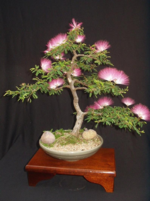Albizia love making taproots. I can recommend going with a wide and shallow pot.
The main issue with taproots is that they're hard to get rid of once they're there; it can kill a tree to cut it off so it's better to prevent them. And in wide and deep pots, there's room and conditions for huge tap roots to form. In wide and shallow pots, the chance that a taproot is going to ruin your tree is minimal because it's less likely to form.
A bigger pot means faster growth, but going too big too fast can mean that one part of the tree might develop faster than the rest; a root escapes the bunch, finds fresh soil, grows like crazy and feeds that side of the tree. For a more stable and easier to direct output, it's better to go gradually larger. In that stage of development (seedling/sapling), it might not matter a whole lot though, and repotting doesn't have to be scheduled like with established plants.. Just do it when the pot is full instead of waiting for the right season. Given of course that you don't trim the roots and just move the plant from one pot to another and fill it up with soil.
The people who advocate against that way of repotting young material, usually repot too soon ("I swear I saw a root dangling from the container and that means that the container is full!" - a common misconception) and damage the root system when they lift the tree; soil falls off/apart and tears the roots apart. A 2 inch pot takes about a year or more to fill up well, there are a couple exceptions. Plants have a general growth pattern, they form large roots to probe the edges of the container first, once that's done they send out smaller feeder/adventitious roots, those will branch out too and eventually fill the entire soil. Some herbaceous and some woody plants do everything (probing, branching, secondary/tertiary branching of roots) at the same time, which leads to the misconception that all plants have a fully rooted container once the first roots escape the pot. Since houseplants dominate the internet and most of those house plants do grow in such a fashion, you're going to find this reasoning a lot if you google around.
Another reason why people advocate against this type of repotting is because they go in and wreak havoc themselves with scissors and rakes while there is no need to do either cutting or raking ("Because that's what repotting is, right?"). Repotting can be anything from changing just the pot, to diving in and removing soil, raking the roots and laying them out, replacing the soil and what not.. If your soil is still in a good condition and your roots are still developing nicely, there's no need for raking or cutting - or sometimes not even a reason to repot. In a good soil, fit to the type of tree you have, there is no cutting or raking necessary to develop a good and branching root system. Pines from seed for instance, don't usually form a taproot in a shallow pot, unless the soil is too coarse. They're also less likely to form one if they're in soggy soil, but that'll give you more risks of drowning - and drowning the taproot is exactly why it doesn't form or why it dies quite fast. While most trees can handle a bit of root damage, it's not always wise to induce it. Especially young material can produce a bunch of new roots near the base of the trunk when conditions are right, without any human interaction. By allowing them to do this on their own instead of forcing it (by snipping off the ends), the tree will end up with a healthier and stronger balance compared to when you force it - here too there are exceptions. From what I've observed, most trees will let old and less functional roots die off naturally if they are allowed to make their own decisions. This results in way less 'shock' and a stable growth output throughout the year, but it could take longer to get to a certain point of development. I'm not saying it's wrong to cut roots, it can be a very functional technique with very nice results and sometimes it's necessary to do so! But it's always wise to contemplate about the why and how, instead of just following protocol. Especially for beginners.



